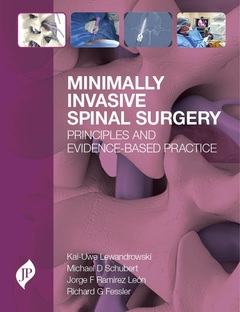Description
Minimally Invasive Spinal Surgery
Principles and Evidence-Based Practice
Authors: Lewandrowski Kai-Uwe, Schubert Michael, Ramírez Léon Jorge F, Fessler Richard G
Language: English
Subjects for Minimally Invasive Spinal Surgery:
Keywords
Approximative price 165.93 €
In Print (Delivery period: 14 days).
Add to cart256 p. · 21.9x27.5 cm · Hardback
Description
/li>Contents
/li>Readership
/li>Biography
/li>
This book provides a timely, comprehensive and evidence-based review of minimally invasive surgery of the cervical, thoracic and lumbar spine.
Minimally invasive techniques are now aided by more advanced endoscopic instruments, video, and computerised navigation systems broadening the range of surgical procedures that can be carried out with similar efficacy as traditional open spinal surgeries, without the significant burden on the patient recovery and rehabilitation.
This book thoroughly reviews the preclinical and clinical data on minimally invasive spinal surgery and describes and illustrates the current effective techniques.
An authoritative, international team of contributors add their clinical experience and expertise to provide a clear, authoritative and practical guide.
The book is organised in four sections covering cervical, thoracic and lumbar spine regions with a final section on the latest advances in technologies and the cost-effectiveness of current treatments.
SECTION 1: MI TECHNIQUES AND APPROACHES TO THE CERVICAL SPINE
1 Thermodiscoplasty (TDP) in cervical discopathy and rhizolysis
2 Transcorporeal foraminotomy for cervical spondylotic radiculopathy
3 Cervical endoscopic versus open foraminotomy for uncovertebral lateral stenosis
4 Endoscopic percutaneous assisted and open posterior cervical foraminotomy
5 Posterior foraminotomy versus anterior cervical disc replacement or fusion
SECTION 2: MI TECHNIQUES AND APPROACHES TO THE THORACIC SPINE
6 Clinical evidence for thoracic discectomy under thoracoscopic guidance
7 Endoscopic transforaminal thoracic discectomy (ETTD)
8 Minimally invasive extracavitary versus open approach for thoracic disc herniation
9 Minimally invasive ventral decompression via oblique paraspinal approach
SECTION 3: MI TECHNIQUES AND APPROACHES TO THE LUMBAR SPINE
10 Clinical outcomes with thermodiscoplasty
11 Percutaneous endoscopic lumbar annuloplasty for treatment of discogenic low back pain
12 Lumbar rhizotomy versus fusion for axial facet pain syndromes
13 Patho-anatomic evidence for endoscopic lumbar discectomy
14 Endoscopic transforaminal, interlaminar and transiliacal approaches for lumbar disc herniation
15 Percutaneous endoscopic intra-annular subligamentous herniotomy
16 Interspinous microscopic tubular decompression for treatment of lumbar spinal stenosis
17 Interspinous process distraction systems for spinal stenosis with or without concomitant degenerative spondylolisthesis
18 Minimally invasive spine surgery for degenerative lumbar disorders
19 Clinical outcomes with endoscopically assisted and open posterior transforaminal lumbar interbody fusion
20 Interbody cage geometry, construct stability and alignment
21 Minimal dissection standalone ALIF in the elderly population
SECTION 4: COST EFFECTIVENESS AND ADVANCED TECHNOLOGIES
22 Transforaminal endoscopic lumbar decompression and foraminoplasty for treatment of the degenerate lumbar spine
23 Advantages of outpatient ambulatory lumbar interbody fusion surgery
24 Advances in transforaminal lumbar interbody fusion
25 Physician extenders as part of an ambulatory spine surgery program
26 Difference in outcomes and patient satisfaction of spinal surgery for lumbar stenosis in minorities
27 Minimally invasive spine surgery for spinal neoplasms
28 Indication and benefit of lumbar spinal hardware removal
29 Percutaneous lumbar facet augmentation in the treatment of lumbar facet arthropathy
30 Trans-sacral epiduroscopic laser decompression
31 Single incision robotic assisted laparoscopic mini-ALIF via transumbilical retroperitoneal approach
32 Percutaneous cement discoplasty: minimally invasive treatment of severe disc degeneration in elderly
Kai-Uwe Lewandrowski MD
Orthopaedic Surgeon, Centre for Advanced Spinal Surgery of Southern Arizona, Tucson, Arizona, USA
Michael Schubert MD
Orthopaedic Surgeon, Apex Spine Centre, Munich, Germany
Jorge F Ramírez Léon MD
Professor, Head Orthopaedics and Traumatology, Director of Spine Centre, Clinica Reina Sofia Colsanitas, Bogota, Columbia
Richard G Fessler MD PhD
Professor and Vice Chair of Neurosurgery, Feinberg School of Medicine, Northwestern University, Chicago, Illinois, USA
These books may interest you

Endoscopic Spinal Surgery 183.14 €



